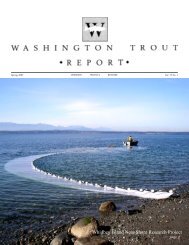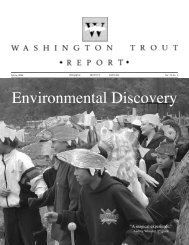Seafood Watch
Pacific Salmon - Wild Fish Conservancy
Pacific Salmon - Wild Fish Conservancy
- No tags were found...
Create successful ePaper yourself
Turn your PDF publications into a flip-book with our unique Google optimized e-Paper software.
<strong>Seafood</strong> <strong>Watch</strong>® Wild Pacific Salmon Report October 8, 2010<br />
Pink Salmon (Oncorhynchus gorbuscha)<br />
Pink salmon are the smallest of North American salmon, with adults weighing on average less<br />
than four pounds and measuring under two feet long (PFMC 2004a). Pink salmon (pinks), also<br />
known as “humpback” salmon because of the pronounced hump that develops on the backs of<br />
mature adult males, maintain a two-year lifecycle, thus large runs follow a biennial pattern.<br />
Distribution<br />
Pink salmon are found on both sides of the North Pacific. On North American shores they extend<br />
from Puget Sound north to Alaska and the Aleutian Islands. In Asia, pink salmon spawn between<br />
Russia, North Korea, and Hokkaido, Japan, and range into the Bering and Okhotsk Seas (Hard et<br />
al. 1996, Froese and Pauly 2004). In latitudinal terms, pink salmon currently spawn around the<br />
Pacific Rim from 44°N to 65°N in Asia and from 48°N to 64°N in North America (Hard et al.<br />
1996).<br />
Currently, Washington appears to be the southern limit of the spawning distribution of pink<br />
salmon in North America (Hard et al. 1996); however, historic pink drainages may have<br />
stretched further south into California (Brownell 1999, Froese and Pauly 2004).<br />
ESUs<br />
The National Marine Fisheries Service has not identified geographically-specific ESUs for pink<br />
salmon in the Pacific Northwest. It has identified, however, odd- and even-year runs, but neither<br />
odd- nor even-year pink salmon runs have been listed as threatened or endangered (NMFS<br />
2004a). In Alaska, pink salmon are not divided by ESUs. Fishery management is instead divided<br />
into four overarching regions: Southeast Alaska, Central Region, Westward Region, and Arctic-<br />
Yukon-Kuskokwim Region. Of these four regions, pink salmon are predominantly harvested in<br />
the first three (Plotnick and Eggers 2004).<br />
Life History Traits<br />
Adult pink salmon enter spawning streams between late June and mid-October (Kingsbury 1994,<br />
Hard et al. 1996). Most pink salmon spawn within a few miles of the coast and spawning within<br />
the intertidal zone or the mouths of streams is common (Steelquist 1992, Kingsbury 1994).<br />
Shallow riffles, where flowing water breaks over coarse gravel or cobble-size rock, and the<br />
downstream ends of pools are favored spawning areas (ADFG 2000). Female pink salmon each<br />
carry 1,500 to 2,000 eggs depending on her size (Steelquist 1992, Kingsbury 1994, Hard et al.<br />
1996). As with the other species of Pacific salmon, females dig nests, or redds, with their tails<br />
and release the eggs, which are then fertilized by males and covered over. The process is<br />
commonly repeated several times until all of the female's eggs have been released, after which<br />
the spawning adults soon die, usually within two weeks (Kingsbury 1994).<br />
Sometime during early to mid-winter, eggs hatch. The alevins, or young fry, feed on attached<br />
yolk sac material, and continue to grow and develop (Kingsbury 1994). In late winter or spring,<br />
the fry swim up out of the gravel and migrate downstream into salt water. The emergence and<br />
outward migration of fry is heaviest during hours of darkness and usually lasts for several weeks<br />
before all the fry have emerged (Kingsbury 1994).<br />
Following entry into salt water, juvenile pink salmon move along the beaches in dense schools<br />
near the surface, feeding on plankton, larval fishes, and occasional insects (Steelquist 1992,<br />
33






